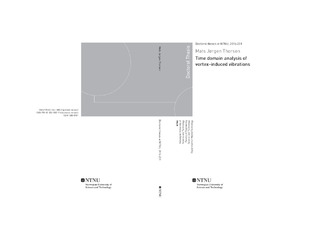| dc.contributor.advisor | Sævik, Svein | |
| dc.contributor.advisor | Larsen, Carl Martin | |
| dc.contributor.author | Thorsen, Mats Jørgen | |
| dc.date.accessioned | 2016-10-12T08:10:28Z | |
| dc.date.available | 2016-10-12T08:10:28Z | |
| dc.date.issued | 2016 | |
| dc.identifier.isbn | 978-82-326-1801-9 | |
| dc.identifier.issn | 1503-8181 | |
| dc.identifier.uri | http://hdl.handle.net/11250/2414408 | |
| dc.description.abstract | This thesis deals with the development of a new empirical model of the hydrodynamic loads associated with vortex-induced vibrations (VIV) of slender circular cylinders. The most commonly used VIV analysis tools operate in the frequency domain, and are unable to account for non-linear structural effects. In addition, these methods cannot handle time varying flows, and interaction with other loads is difficult to account for.
To dispose of the limitations associated with frequency domain analyses, a new method for time domain simulation of VIV is proposed in this work. Different load formulations are explored, and the final version consists of the well-known Morison's equation for inertia and drag forces, plus an additional term that models the effect of vortex shedding. A key component is a synchronization model which simulates how the vortex shedding reacts to structure motion to obtain lock-in. To evaluate the hydrodynamic load model, numerical simulations of a rigid cylinder subjected to an incoming flow and forced cross-flow oscillations are performed. Comparison with published experimental results shows that the proposed model reproduces the basic behavior of the fluctuating lift force.
To predict VIV of flexible cylinders, the hydrodynamic load model is combined with a finite element structural model. A linear beam model is utilized to simulate VIV of a riser in uniform and sheared stationary flow. Fatigue damage is calculated based on rainflow counting and Miner-Palmgren summation, and comparison with experimental data shows reasonable agreement. The uncertainties associated with VIV fatigue damage are however significant, and safety factors are necessary in some cases to obtain conservative results.
The proposed model has no restrictions on the time variability of the incoming flow, and through comparison with experimental data, it is demonstrated that the model accurately predicts the unstable VIV of a flexible cylinder subjected to a sinusoidal oscillating flow at two different KC-numbers. In the high KC-number case, the VIV response is intermittent, with vibrations continuously building up and dying out. It is also shown that multi-mode response occurs in oscillating flow when the reduced velocity is above a certain level, and the cylinder mass ratio is found to be important for the mode participation.
Finally, the hydrodynamic load model is implemented in a non-linear finite element program for dynamic analysis of slender structures. This is used to simulate VIV of a truncated model scale steel catenary riser in two different conditions: uniform stationary flow and oscillating relative flow caused by prescribed top-end motion. The predicted strains show good agreement with experiments, although some discrepancies are seen. | nb_NO |
| dc.language.iso | eng | nb_NO |
| dc.publisher | NTNU | nb_NO |
| dc.relation.ispartofseries | Doctoral thesis at NTNU;2016:231 | |
| dc.relation.haspart | Paper 1: Thorsen, Mats Jørgen; Sævik, Svein; Larsen, Carl Martin.
A simplified method for time domain simulation of cross-flow vortex-induced vibrations. Journal of Fluids and Structures 2014 ;Volum 49. s. 135-148 <a href="http://dx.doi.org/10.1016/j.jfluidstructs.2014.04.006" target="_blank"> http://dx.doi.org/10.1016/j.jfluidstructs.2014.04.006</a> | |
| dc.relation.haspart | Paper 2:
Thorsen, Mats Jørgen; Sævik, Svein; Larsen, Carl Martin.
Fatigue damage from time domain simulation of combined in-line and cross-flow vortex-induced vibrations. Marine Structures 2015 ;Volum 41. s. 200-222 <a href="http://dx.doi.org/10.1016/j.marstruc.2015.02.005" target="_blank"> http://dx.doi.org/10.1016/j.marstruc.2015.02.005</a> | |
| dc.relation.haspart | Paper 3:
Thorsen, Mats Jørgen; Sævik, Svein; Larsen, Carl Martin.
Time domain simulation of vortex-induced vibrations in stationary and oscillating flows. Journal of Fluids and Structures 2016 ;Volum 61. s. 1-19
<a href="http://dx.doi.org/10.1016/j.jfluidstructs.2015.11.006" target="_blank"> http://dx.doi.org/10.1016/j.jfluidstructs.2015.11.006</a> | |
| dc.relation.haspart | Paper 4:
M.J. Thorsen, S. Sævik and C.M. Larsen. Non-linear time domain analysis of crossflow
vortex-induced vibrations
© 2016 This manuscript version is made available under the CC-BY-NC-ND 4.0 license http://creativecommons.org/licenses/by-nc-nd/4.0/ | |
| dc.title | Time Domain Analysis of Vortex-Induced Vibrations | nb_NO |
| dc.type | Doctoral thesis | nb_NO |
| dc.subject.nsi | VDP::Technology: 500::Marine technology: 580 | nb_NO |
